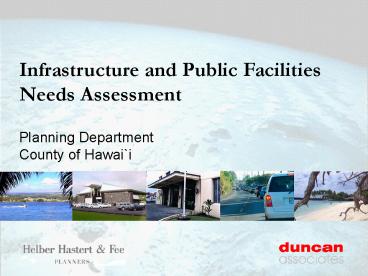Impact Fees - PowerPoint PPT Presentation
1 / 23
Title:
Impact Fees
Description:
... Planning, University of Texas. Introducing ImpactFees.com ... Authorizes counties to adopt impact fees. Based on established legal constitutional standards ... – PowerPoint PPT presentation
Number of Views:49
Avg rating:3.0/5.0
Title: Impact Fees
1
Infrastructure and Public Facilities Needs
Assessment Planning Department County of Hawaii
2
Key Personnel
- Scott H. Ezer
- Principal, Helber Hastert Fee
- 28 Years Planning and Urban Design Experience
- Co-Author, Honolulu Land Use Urban Design
Ordinances - Master of Urban and Regional Planning, University
of Hawaii - James B. Duncan, FAICP
- 43 Years Planning and Impact Fee Experience
- Manager, Nations First Multi-Facility Impact Fee
System - Co-Author, Nations First Impact Fee Enabling Act
- Master of Urban Planning, University of Oklahoma
- Clancy J. Mullen, AICP
- 18 Years Planning and Impact Fee Experience
- Impact Fee Specialist, Duncan Associates
- Author of Over 200 Impact Fee Studies
- Master of Urban Planning, University of Texas
3
Introducing ImpactFees.com
4
Our National Experience
5
Fee Experience By Facility
6
What Is An Impact Fee?
- One-time fee payment
- by new development
- for off-site capital facilities
- needed by new development.
7
What An Impact Fee Is Not?
- Barrier for affordable housing
- Impediment for move-up buyers
- Local funding panacea
- Difficult to administer
- No-growth tool
8
Why Impact Fees are Popular
- Replace vanishing traditional funding
- Deter declining levels of service
- Create level playing field for developers
- Add certainty to development process
- Soften anti-growth public sentiment
- Offset increasing taxes and rates
9
What Is The Legal Basis For Fees?
- Must create need for new facilities
- Must receive benefit from new facilities
- Must only pay fair share of new facilities
10
Impact Fee Authority
11
1992 Hawaii Impact Fee Act
- Authorizes counties to adopt impact fees
- Based on established legal constitutional
standards - Eligible facilities are those specifically
identified in comprehensive plan or facility
needs assessment study. - Specify service level standards for each facility
- Cannot charge for higher than existing LOS
- Funds and interest earned earmarked by facility
- Past property tax payments must be credited
- Spend on planning, design and construction
- Spend within 7 years or refund
- Collect fee prior to grading or building permit
- Other available funding options must be examined
- Only use 2002 Honolulu road fee for EWA region
12
What Is The Average Impact Fee?
13
Work Plan and Schedule
14
Growth Context
15
Fair Share Assessments
- Imposed Since Early 1990s
- Apply to New Residential/Hotel Zoning
- Based on 1990 StudyNever Adopted
- Calculated Fees Indexed Annually for Inflation
- Substantial Fees 9,991 per Unit
- Roads, Parks, Fire, Police, Solid Waste
- Little Revenue 74 million Assessed, but only
3.6 million Collected 15.2 million Credits - Speculative Zoning
- Existing Zoning Not Assessed (11,000 Units)
- Existing Vacant Lots (64,000 Units)
- Applies only to Residential/Hotel Development
16
Drawback of Fair Share Assessments
- Major Capital Needs 439 million for County
roads by 2020 - Fair Share Assessments Only 19 million since
early 1990s in cash and construction - Impact Fee at Building Permit Would have
brought in 103 million since 2000
17
Lots in Older Subdivisions
- In 1950s and 1960s, Subdivisions Allowed with
Minimal Improvements - 40,000 Vacant Substandard Lots in Puna
- 13,000 Vacant Substandard Lots in Kau
- 37 of 1990s Growth in Older Subdivisions
- Concern about Imposing Impact Fees
- Many Lots Owned by Long-Time Residents
- Source of Affordable Housing
18
Ownership of Vacant Resid. Lots
Note Lots with residential zoning, excluding
lots over 20 acres or with more than 10,000 in
yard or outbuilding improvements
19
Recommended Approach
- Replace Fair Share with True Impact Fees
- Adopt as Ordinance
- Comply with Requirements of State Act
- Apply to All New Development
- Assess Nonresidential Development
- Apply to Areas with Existing Zoning
- County-Wide Fee Calculation
- Multiple Benefit Districts
- Progressive Residential Rates
20
Options for Dealing with Existing Lots
- Allow one dwelling unit per existing lot of
record with no fee charged - Would exempt most single-family development
(about half of potential revenue) - Allow grace period (e.g., 1-5 years) for
single-family lots of record to be developed with
no fee - Same effect on revenue in short-term
- Negligible revenue impact in long-term
21
Alternatives
- No Change from Fair Share Assessments at Zoning
- Expand Fair Share to Nonresidential Zoning
- Collect Impact Fees at Subdivision (i.e., exempt
buildable lots) - Collect Impact Fees at Building Permit
- Allow One Dwelling Unit per Existing Lot of
Record - Allow 1-5 Year Grace Period for Residential Lots
of Record - No Exemptions or Grace Period
22
Advantages of Impact Fees at Building Permit
- Greater Revenue Potential
- County Only Getting About 2 Million Annually Now
- Nonresidential Road Impact Fees at Current
Calculated Levels Would Bring in 12 Million per
Year - Residential Fees on Half of Building Permits
Issued Would Bring in 10 Million Annually - Greater Equity
- All Development Pays, Not Just Residential that
Needs Zoning - Larger Homes Pay More Based on Greater Impact
- More Legally Defensible
- Comply with State Impact Fee Act
23
Questions? . . .































